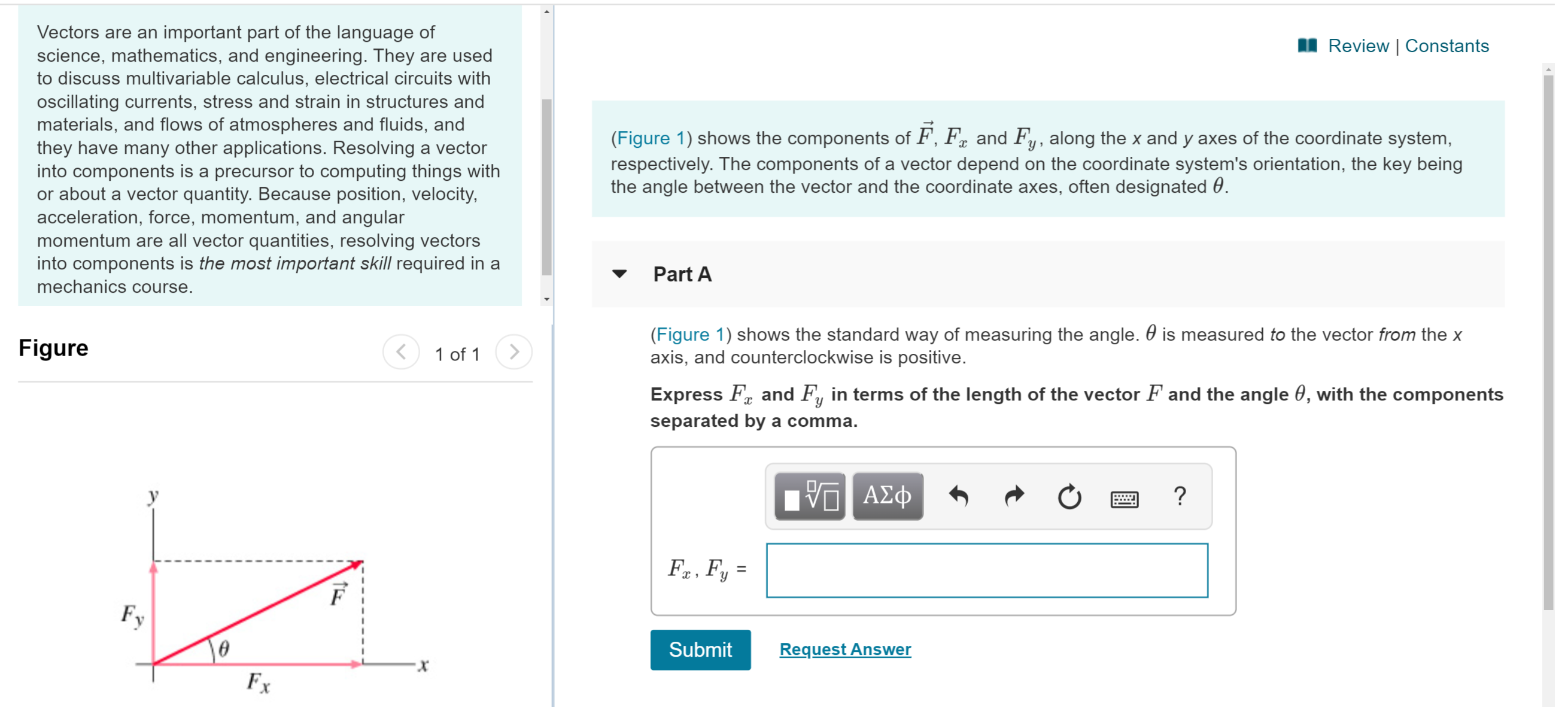Vectors are an important part of the language of science, mathematics, and engineering. They are used to discuss multivariable calculus, electrical circuits with Review | Constants oscillating currents, stress and strain in structures and materials, and flows of atmospheres and fluids, and they have many other applications. Resolving a vector into components is a precursor to computing things with or about a vector quantity. Because position, velocity, acceleration, force, momentum, and angular momentum are all vector quantities, resolving vectors into components is the most inmportant skill required in a mechanics course. (Figure 1) shows the components of F, Fr and Fy, along the x and y axes of the coordinate system, respectively. The components of a vector depend on the coordinate system's orientation, the key being the angle between the vector and the coordinate axes, often designated Part A (Figure 1) shows the standard way of measuring the angle. 0 is measured to the vector from the x axis, and counterclockwise is positive. Figure 1 of 1 Express Fa and Fy in terms of the length of the vector F and the angle 0, with the components separated by a comma. ΑΣφ ? Fx. Fy = Fy Submit Request Answer Fx
Vectors are an important part of the language of science, mathematics, and engineering. They are used to discuss multivariable calculus, electrical circuits with Review | Constants oscillating currents, stress and strain in structures and materials, and flows of atmospheres and fluids, and they have many other applications. Resolving a vector into components is a precursor to computing things with or about a vector quantity. Because position, velocity, acceleration, force, momentum, and angular momentum are all vector quantities, resolving vectors into components is the most inmportant skill required in a mechanics course. (Figure 1) shows the components of F, Fr and Fy, along the x and y axes of the coordinate system, respectively. The components of a vector depend on the coordinate system's orientation, the key being the angle between the vector and the coordinate axes, often designated Part A (Figure 1) shows the standard way of measuring the angle. 0 is measured to the vector from the x axis, and counterclockwise is positive. Figure 1 of 1 Express Fa and Fy in terms of the length of the vector F and the angle 0, with the components separated by a comma. ΑΣφ ? Fx. Fy = Fy Submit Request Answer Fx
Algebra & Trigonometry with Analytic Geometry
13th Edition
ISBN:9781133382119
Author:Swokowski
Publisher:Swokowski
Chapter8: Applications Of Trigonometry
Section8.4: The Dot Product
Problem 48E
Related questions
Question

Transcribed Image Text:Vectors are an important part of the language of
science, mathematics, and engineering. They are used
to discuss multivariable calculus, electrical circuits with
Review | Constants
oscillating currents, stress and strain in structures and
materials, and flows of atmospheres and fluids, and
they have many other applications. Resolving a vector
into components is a precursor to computing things with
or about a vector quantity. Because position, velocity,
acceleration, force, momentum, and angular
momentum are all vector quantities, resolving vectors
into components is the most inmportant skill required in a
mechanics course.
(Figure 1) shows the components of F, Fr and Fy, along the x and y axes of the coordinate system,
respectively. The components of a vector depend on the coordinate system's orientation, the key being
the angle between the vector and the coordinate axes, often designated
Part A
(Figure 1) shows the standard way of measuring the angle. 0 is measured to the vector from the x
axis, and counterclockwise is positive.
Figure
1 of 1
Express Fa and Fy in terms of the length of the vector F and the angle 0, with the components
separated by a comma.
ΑΣφ
?
Fx. Fy =
Fy
Submit
Request Answer
Fx
Expert Solution
This question has been solved!
Explore an expertly crafted, step-by-step solution for a thorough understanding of key concepts.
This is a popular solution!
Trending now
This is a popular solution!
Step by step
Solved in 4 steps with 3 images

Recommended textbooks for you

Algebra & Trigonometry with Analytic Geometry
Algebra
ISBN:
9781133382119
Author:
Swokowski
Publisher:
Cengage

Algebra & Trigonometry with Analytic Geometry
Algebra
ISBN:
9781133382119
Author:
Swokowski
Publisher:
Cengage